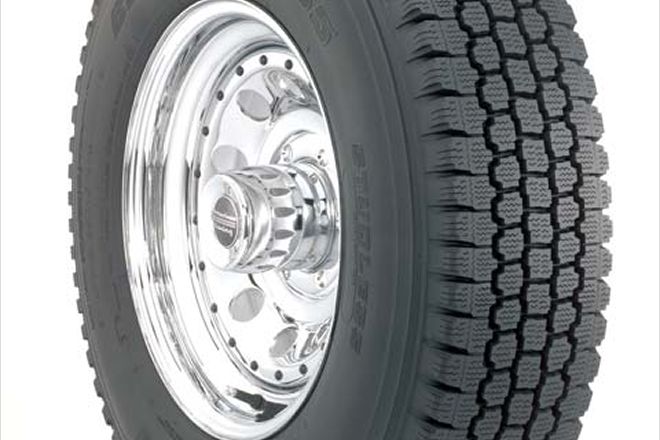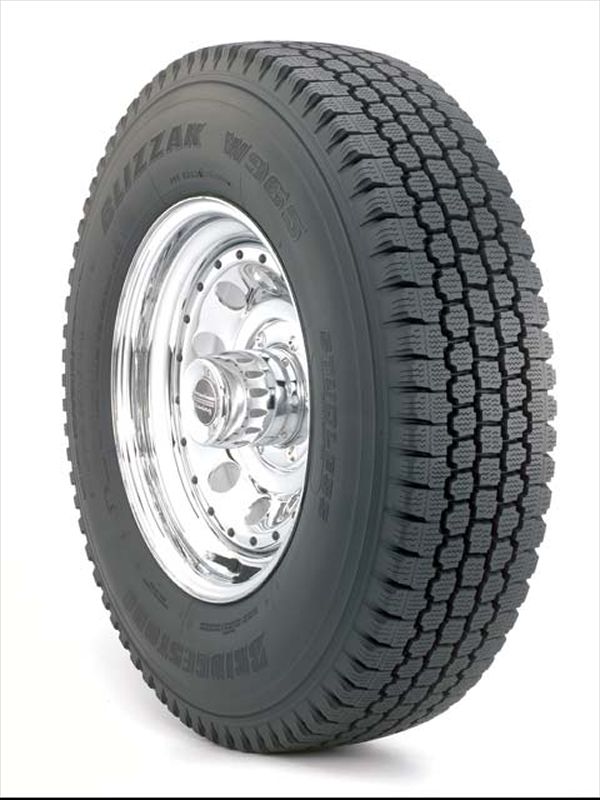
No chains, no studs, and no white knuckles: While these were great benefits of the Bridgestone Blizzak, we were also surprised to have the added bonus of increased wet pavement traction, reduced road noise, and improved ride comfort.

Tread depth cautions were being circled on the service sheets of our F-250 Super Duty about the time we were getting ready to gear up for another ski season. So we figured it was good timing for a set of winter tires. For once it would be nice to have tires approved as traction devices for the Oregon mountain passes, so we had our local Bridgestone dealer mount a set of Bridgestone Blizzak W965 tires in an LT265/75R16 size.
The first thing we noticed was a quieter, smoother ride with the Blizzak tires. With the softer and thicker tread compound between our truck and the road surface, rough roads felt less so. Obstacles that normally caused some teeth rattling, like highway expansion joints and bridge transitions, were barely perceptible.
With the exception of an occasional rock stuck in the deep treads, things got much quieter as well. The Blizzaks rolled right through a variety of speed ranges without emitting noticeable road noise.
We also experienced a marked improvement in wet pavement traction. Our Super Duty had recently received some diesel performance upgrades that frequently generated wheelspin on wet pavement in two-wheel drive, even with light throttle input. When shod with the Blizzaks, the big torque was manageable even in the wettest conditions.
"Directional tires channel water out laterally, but the Blizzak is designed with lots of void to give the water a place to go within the footprint," according to Bill VandeWater, Bridgestone Consumer Products Manager Sales Engineering. This allows the tread blocks to touch the road surface.
Our ice driving test for the Blizzak tires took us by surprise as we headed north on Oregon's I-5 very early one morning. Ground level temperatures were below freezing and it was raining when we noticed something we didn't like at all-no spray coming off of the tires of the big rigs. Soon after noticing this warning, we saw southbound headlights in the northbound lanes-lots of them-belonging to spun-out vehicles.
We went around several cars that were stopped, facing the wrong way, against guardrails or on the shoulder. The Blizzaks performed remarkably well in these conditions. The biggest challenge we had was positioning our truck so it was not a target for vehicles with less grip.
The siping in the Blizzak tread design aids ice traction dramatically. From a distance, the tread blocks look solid but upon close examination there are separations or slots, much like a pre-sliced loaf of bread. As tread blocks put pressure on the ice, a thin layer of water forms, which is the primary reason why gripping on ice is so difficult. The Blizzak tread block sipes open to give this water a place to go, which allows the rubber to grip the ice. At the same time, these individual slices of tread block provide more edges to increase grip.
The Blizzaks were right at home on our trips above the snowline in the Cascades. The voids in the treads stayed clean in fresh snow, and we found that the Blizzak performed well in both fresh snow and packed snow. While this takes a little of the squirrely fun out of playing in the snow, it adds up to a big increase in security when safety really counts. We got better starts, improved handling, and surer stops in both snow and ice.
Another feature of a good winter tire is softer tread compounds. "Tread compounds are designed to operate within specific temperature ranges," says VandeWater. "Above that range, tires tend to get too soft and wear rapidly. Below that range, tires will become too hard and not conform to the road surface." This latter condition results in reduced traction.
The soft tread compound that helps make the Blizzak so superior as a winter tire also means it wears quickly in summer conditions. The Blizzak is not an all-season tire.
The Bridgestone Blizzak tires we tested delivered outstanding performance in winter driving conditions. We're looking forward to putting them back on the truck when the winter driving season approaches again-for the comfort and quiet but most of all for the confidence that comes with having the right tire for the worst the winter can dish out.
Tire: Bridgestone Blizzak W965 with UNI-T
Size: LT265/75R16
Type: Radial
Load range: E
Max load (lb. @ psi): 3,042 @ 80
Sidewall: Two-ply polyester
Tread: Two-ply polyester, two-ply steel, one-ply nylon
Approved rim (in.): 7.0-8.0
Tread depth (in.): 18/32
Tread width (in.): 7.6
Section width (in.): 10.5
Overall diameter (in.): 31.9
Static loaded radius (in.): 14.8
Revs per mile: 653
Weight (lb.): 46
Test vehicle: Ford F-250 Super Duty 4x4 extended-cab